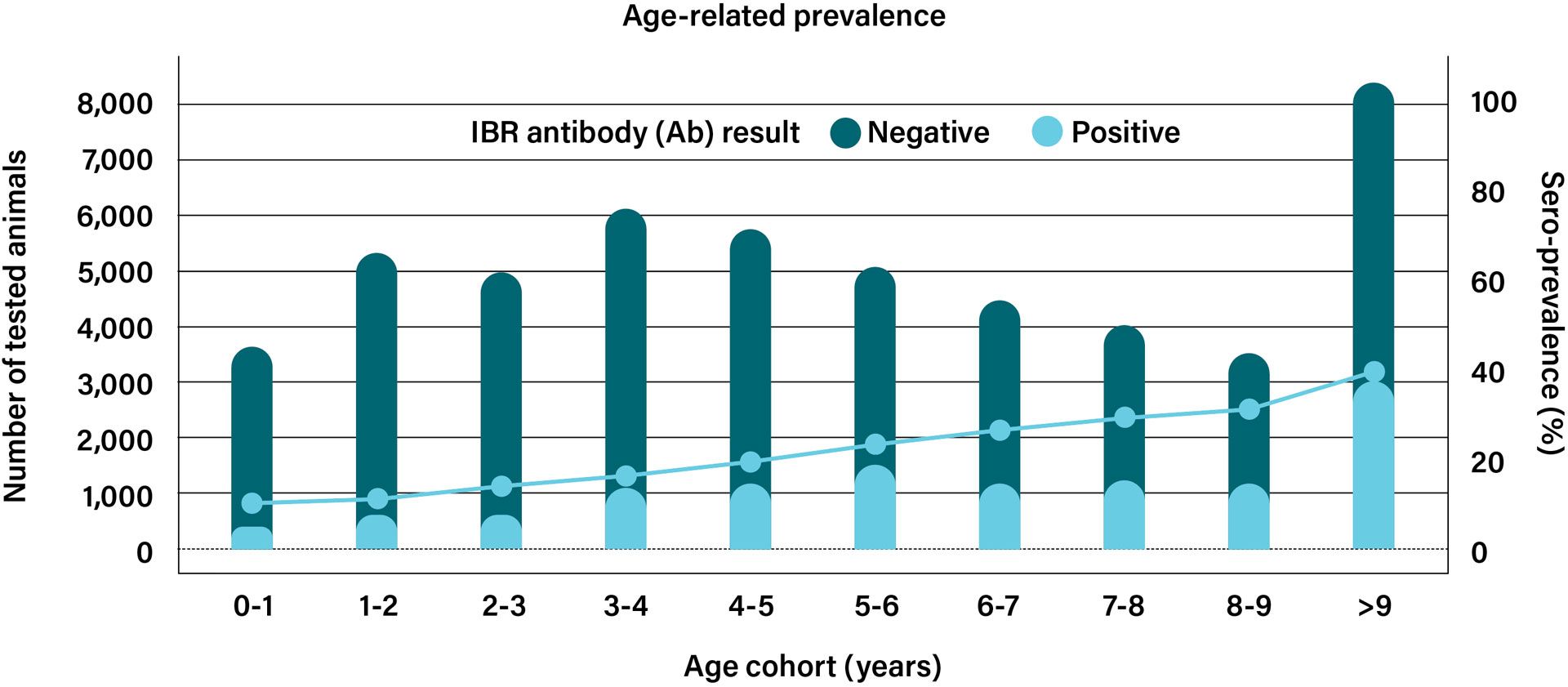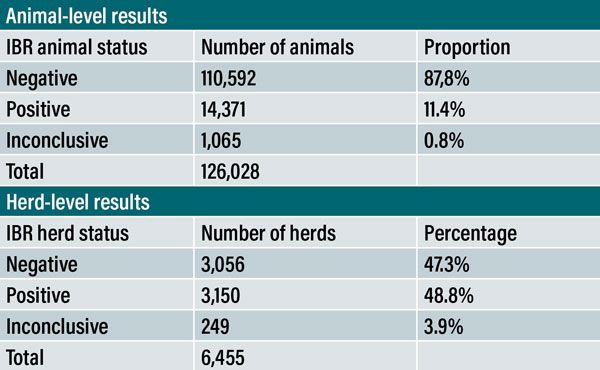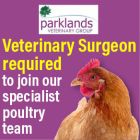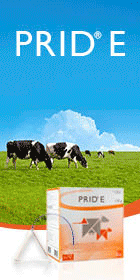IBR testing results in Irish beef herds – NBWS 2023
Dr Maria Guelbenzu DVM PhD MRCVS, BVD and IBR programme manager with Animal Health Ireland, provides an overview of IBR testing in beef herds as part of the National Beef Welfare Scheme (NBWS) 2023
The Department of Agriculture, Food and the Marine (DAFM) introduced the National Beef Welfare Scheme (NBWS) to enhance animal health and husbandry on Irish suckler farms in 2023. The scheme supported farmers in meal feeding suckler calves in advance of, and after, weaning and in testing for the presence of infectious bovine rhinotracheitis (IBR) in their herds.
IBR is a highly infectious respiratory disease caused by the bovine herpesvirus type 1 (BoHV-1). BoHV-1 is one of eight herpesviruses known to infect cattle. The disease can manifest in various forms, including respiratory, reproductive, and neurological signs, and can have significant economic implications for cattle farmers. Understanding the prevalence and epidemiology of IBR is crucial for the development of effective prevention and control strategies.
The main objective of this article is to provide an overview on the results obtained through IBR testing under the NBWS 2023.
Material and methods
In total, 10,650 beef breeding herds submitted one or more samples through the NBWS IBR testing programme. This constitutes approximately 20 per cent of the entire Irish beef herd population.
To determine the herd-level IBR status, a ‘snapshot’ test was performed. The snapshot required the sampling of 20 randomly-selected animals over nine months old (to ensure there were no maternal antibodies remaining) and that were used, or intended, for breeding. It was important to include animals of all ages and groups in this testing to obtain a result that truly reflected the status of the herd. Where a herd had 20 or more bovines, a minimum of 20 were to be tested and where a herd had fewer than 20 bovines, all were to be tested, including those under nine months of age.
The samples were collected by local practising veterinarians and submitted to one of the laboratories detailed in the DAFM’s terms and conditions. These laboratories were ISO17025 accredited for the gE antibody ELISA test. On receipt of samples, the laboratories recorded in the Irish Cattle Breeding Federation (ICBF) database the number of samples received per herd in advance of testing the samples.
Samples were tested and classified into an output of positive, negative, or inconclusive, depending on the manufacturers’ thresholds and the results sent to the vets and to the ICBF database. The herd-level IBR status was determined based on the presence of IBR antibodies in the tested animals. Herds were classified as IBR-positive if at least one animal within the herd tested positive for IBR antibodies. For the following analysis, inconclusive results were considered negative. Furthermore, for the analysis, herds were only retained for which complete results were available or a single test result was missing. This was the case when all expected test results were available for a herd (up to 20 tests depending on herd size), or if only one result was missing.

Figure 1. Herd type distribution. Five different subtypes of beef herds have been identified in Ireland, which are consistent with recognised production systems that differ in their management characteristics including when animals are sold for further production. Beef suckling to weanling (BSW) producers maintain a herd of cows and raise calves from birth to weaning, with the majority sold as weanlings at autumn sales during September and October while a proportion of female calves is kept for heifer replacement. The beef suckling to youngstock (BSY) subtype is similar to BSW, including retaining a proportion of females as replacements, with the key difference being that calves are kept for a longer period, to allow weaned calves to gain weight prior to sale. These animals are usually yearlings (12–20 months of age) by the time they leave their birth herd. Non-rearing suckling to youngstock (BSY-NR) herds are a variation of the BSY herd type, with the difference that female calves are sold after weaning and replacement bred females are purchased. The suckling to beef (BSB) herds follow the full beef production cycle, from birth through to the age of slaughter. Finally, representing only a small proportion of the beef sector in Ireland, beef pedigree (BP) herds are an important source of pedigree breeding stock to other commercial cattle producers in both the dairy and beef sectors.
Descriptive analysis
A descriptive analysis of the IBR antibody data was conducted to provide a comprehensive understanding of the status of the disease within the tested cattle herds.
Firstly, the representativeness of the herds tested was assessed by comparing the distribution of herd types and herd sizes in the NBWS herds to the distribution of all beef breeding herds in Ireland. For this analysis herd demography data for all registered beef breeding herds was obtained from the Animal Identification and Movement (AIM) database maintained by the DAFM. The intention of this analysis was to ensure that the results could be extrapolated to the national level.
In a second step, the herd- and animal-level apparent prevalences were calculated, along with their respective 95 per cent confidence intervals. The animal-level prevalence calculation process involved dividing the number of animals testing positive for IBR antibodies by the total number of animals tested. Similarly, the herd-level prevalence was determined by considering the presence of at least one animal testing positive for IBR antibodies within a specific herd.
Results
Study herds
Blood samples were received for 10,659 beef herds and individual test results were available for 189,404 animals. Of the 10,642 herds for which results were available, 6,455 herds (60.5 per cent of all NBWS IBR participating herds) had complete records or only a single result missing. For the remaining 4,204 herds at least two results were missing. In the following analysis, data for the 6,455 herds with complete or nearly complete data is presented and are referred to as ‘study herds and animals’. In these herds, a total of 126,028 individual tests results were available.

Figure 2. Comparison of herd size and herd size cohort distribution.
Representativeness of study herds and animals
Figure 1 shows the distribution of herd types in NBWS herds in comparison with the distribution of all beef breeding herds in Ireland. Beef suckling to weanling (BSW) herds, which maintain a herd of cows and raise calves from birth to weaning, are by far the most represented herd type in both populations.
Based on this assessment, the herds surveyed in the NBWS appear to be a representative subset of all beef breeding herds in Ireland in terms of herd type composition. However, there are some differences in herd size distribution between NBWS herds and the overall population of beef herds.
While the overall distribution of herd sizes was roughly consistent between NBWS herds and all beef herds, NBWS herds tended to be larger on average (mean herd size: all beef herds – 49.2 animals vs NBWS herds – 81.7 animals) (Figure 2). This was mainly due to small herds (0-20 animals) being underrepresented in the NBWS sample.

Figure 3. Snapshot of within-herd prevalence (percentage of samples testing positive per herd, i.e., 15.4 per cent of herds had 0-10 per cent within-herd prevalence, 13.83 per cent had 10-20 per cent within-herd prevalence etc.).
Prevalence estimation
Among the 126,028 study animals, 14,371 returned a positive result, which meant an animal-level apparent prevalence of 11.4 per cent (95 per cent confidence interval [CI]: 11.2 per cent-11.6 per cent) (see Table 1). The majority of animals were negative (87.8 per cent), while 0.8 per cent yielded inconclusive results. At the herd level, our data indicated a herd-level apparent prevalence of 48.8 per cent (95 per cent CI: 47.6 per cent-50.0 per cent).
For the 6,445 study herds, the snapshot of the distribution of the within-herd prevalence is shown in Figure 3. In 51.3 per cent of tested herds no positive animal was detected. In a further 15 per cent of study herds, the snapshot of within-herd prevalence was <10 per cent.
Age-related apparent prevalence
For all positive herds (n = 3,150) we show the age-related prevalence in Figure 4. As expected from previous studies, the proportion of seropositive animals was higher in older animals (e.g., 40 per cent of all animals >9 years old tested in seropositive herds returned a positive IBR antibody test).
Discussion
The NBWS 2023 constitutes the largest sample of suckler herds tested for IBR in Ireland to date.
The results from this analysis show that, in the context of the Irish beef cattle sector, IBR remains endemic albeit at a lower prevalence than previously reported. While previous studies reported notably high prevalence rates (Cowley et al., 2011; Sayers et al., 2015; Barrett et al., 2018), the current herd-level prevalence of 49 per cent reflects a decrease from previous findings. This decline in prevalence could be attributed to various factors such as improved biosecurity measures, vaccination strategies, or changes in farming practices that have contributed to a reduction in IBR transmission within herds.
The substantial proportion of positive herds (30 per cent) with within-herd prevalence below 20 per cent suggests that targeted interventions in these herds could lead to rapid containment and potentially facilitate the eradication of IBR on a broader scale. It also highlights that a higher proportion of herds than previously thought would be in a position to pursue IBR-free status in the context of an IBR programme.
In this study, a snapshot testing strategy was employed to assess the herd-level IBR antibody status. This involved testing a random sample of up to 20 animals from each of the 10,650 beef breeding herds participating in the NBWS. If the NBWS testing approach were extrapolated to the national herd, the approximately 27 per cent of beef herds which have 20 or fewer animals would undergo full herd testing through the snapshot, with a high proportion anticipated to return negative results.

Figure 4. Age-related prevalence, showing number of animals tested and their results (bars, left axis) and the percentage of each age cohort testing positive (line, right axis) for herds returning one or more ELISA positive results. Inconclusive results not included.
Where to access the results for specific farms?
Veterinary practitioners are able to access NBWS IBR results for those farmers who gave them permission through the ICBF. From both the desktop and the mobile versions, choose the ‘National Beef Welfare Scheme’ options on the main menu, then the ‘IBR Dashboard’. This dashboard will show a summary of all the farms that have given permission to the user. When clicking in an individual herd, the IBR dashboard will appear. The status of all animals currently in the herd are summarised. Results for the individual animals represented in each bar can be accessed by clicking on the bars. Please note that if tested animals have since left the herd, their results will not be included in this display.
Conclusion
IBR remains a significant concern within the Irish beef cattle sector. This study, conducted under the NBWS, provides a comprehensive analysis of the prevalence associated with IBR infection in Irish beef herds. The findings highlight a herd-level prevalence of 48.8 per cent and an animal-level prevalence of 11.4 per cent, indicating that IBR is endemic in the population. While these prevalence rates reflect a reduction from previous studies, they underscore the persistent challenge posed by the disease.

Table 1. Animal- and herd-level apparent prevalence.
Barrett, D., Parr, M., Fagan, J., Johnson, A., Tratalos, J., Lively, F., et al. (2018). Prevalence of Bovine Viral Diarrhoea Virus (BVDV), Bovine Herpes Virus 1 (BHV 1), Leptospirosis and Neosporosis, and associated risk factors in 161 Irish beef herds. BMC Vet Res 14, 8. doi: 10.1186/s12917-017-1324-9
Cowley, D. J. B., Clegg, T. A., Doherty, M. L., and More, S. J. (2011). Aspects of bovine herpesvirus-1 infection in dairy and beef herds in the Republic of Ireland. Acta Vet Scand 53, 40. doi: 10.1186/1751-0147-53-40
Sayers, R. G., Byrne, N., O’Doherty, E., and Arkins, S. (2015). Prevalence of exposure to bovine viral diarrhoea virus (BVDV) and bovine herpesvirus-1 (BoHV-1) in Irish dairy herds. Res Vet Sci 100, 21–30. doi: 10.1016/j.rvsc.2015.02.011
1. An IBR snapshot test:
A. Is a cost-effective way to establish a herd’s IBR status
B. Includes the sampling of 20 animals when tested as part of the NBWS
C. Requires animals to be randomly selected and preferably over nine months of age
D. All of the above
2. What statement is true in relation to the IBR snapshot test?
A. No direct correlation exists between the prevalence detected at the snapshot test and within-herd prevalence
B. In order for the results to be representative, sampled animals must not be randomly selected
C. Youngest animals should not be sampled
D. When sampling 20 animals, a snapshot overestimated or underestimated the true prevalence within the herd by 20 per cent on average
3. Analysis of the NBWS IBR results:
A. Showed that the herd-level prevalence is higher than previously thought
B. Showed very low participation
C. Only included young animals
D. Showed an apparent herd prevalence of 49 per cent
4. What statement is not true in relation to the NBWS IBR results?
A. Participating herds were representative of the Irish beef herds
B. It is the largest sample of beef herds ever tested for IBR in Ireland
C. The prevalence obtained is higher than what was found in previous studies
D. A substantial proportion of herds had a within-herd prevalence below 20 per cent
ANSWERS: 1D; 2C; 3D; 4C.









